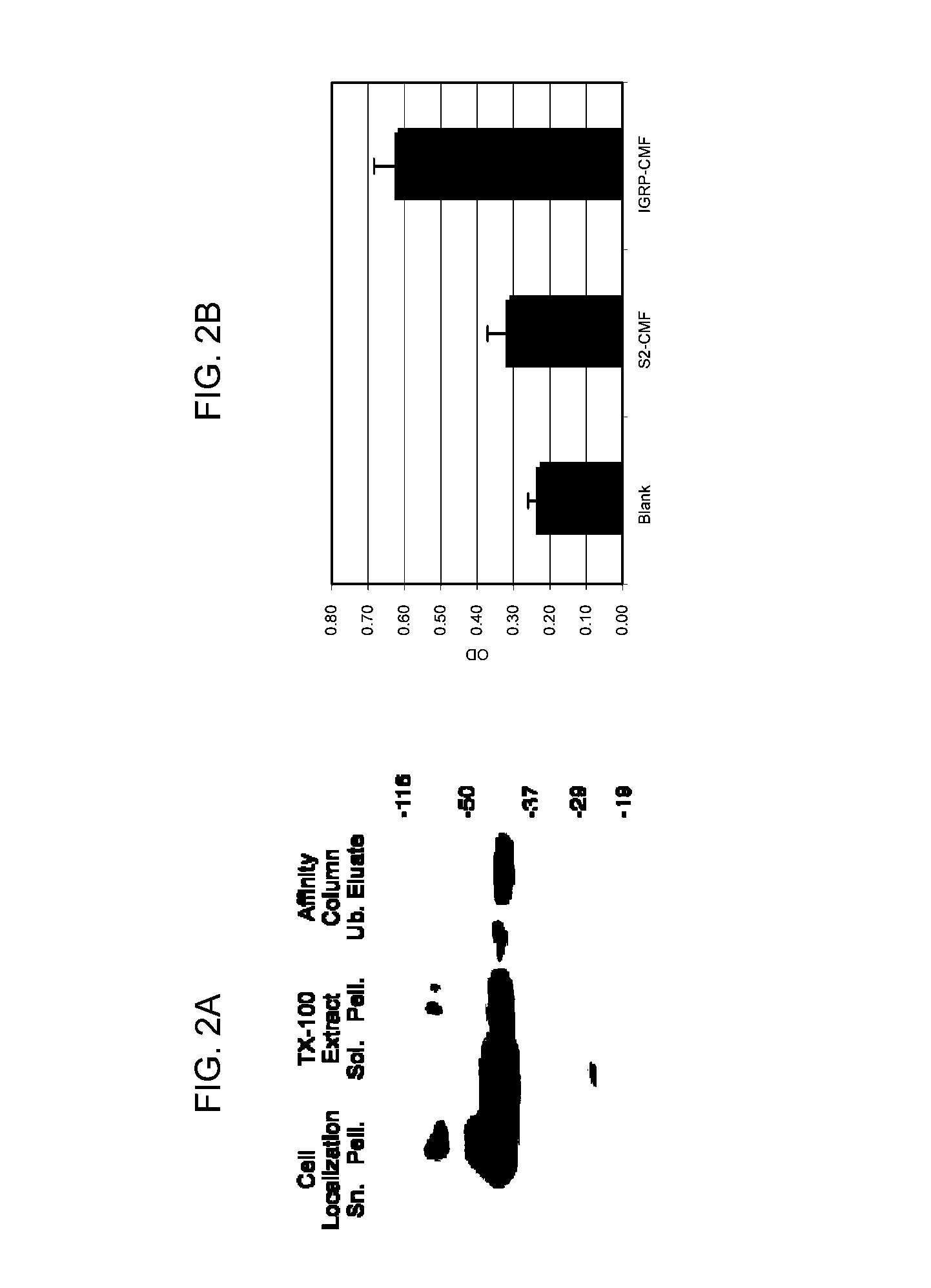Diagnostic and therapeutic target for autoimmune diseases and uses thereof
a technology for identifying autoantigens and identifying them, which is applied in the field of autoantigen targets in type i autoimmune diabetes, can solve the problems of protecting responses, long and insufficient comprehensiveness of list of known immune targets
- Summary
- Abstract
- Description
- Claims
- Application Information
AI Technical Summary
Benefits of technology
Problems solved by technology
Method used
Image
Examples
example 1
[0249]The following example describes the initial identification of ZnT8 (also known as Slc30a8) as a novel diabetes autoantigen.
[0250]The inventors performed oligonucleotide microarray experiments using human U133 and mouse MOE430 Affymetrics chips that cover virtually the entire genome as well as the Panchip 5.0 that reports on gene transcripts in mouse pancreas. Data has been obtained from isolated islets from normal mice, diabetic models (NOD and ob / ob) and mice with deficiencies in the IAPP gene and Ngn 3 as well as from mouse pancreatic tumor cell lines (aTC1-6 glucagonoma, βTC3 and Min6 insulinomas and mPAC ductal tumor line). The data has been analyzed to highlight transcripts that display islet cell-type-specific expression, and their segregation between pancreatic α- and β-cells. Further analysis based on gene ontology (GO) annotation has been used to generate genelists both for human and mouse of candidate autoantigens. Of the 10 highest scoring candidates, 5 are known di...
example 2
[0270]The following example describes assays to identify additional targets of humoral and cell-mediated autoimmunity by further evaluating the shortlist of potential candidates in Table 3 (see Example 1).
[0271]Initially, for unfamiliar candidates and molecules represented only as ESTs, full length clones are obtained, and in situ hybridization analyses are performed on human and mouse pancreas tissue to verify their expression in the β-cell.
Screening Candidate Antigens by Serological Analyses in Human Subjects.
[0272]These assays are best performed in human subjects since they are likely to show a wider spectrum of autoimmune responses because of the genetic diversity and complexity of immune response genes. Large numbers of samples also can be screened per day using semiautomated procedures in 96 well format at low cost per sample. The Barbara Davis Center has archived tens of thousands of samples that are well annotated and analyzed with respect to HLA haplotype, autoreactivity to...
example 3
[0283]The following example describes additional experiments related to the identification of ZnT8 as a novel marker and target of diabetes autoimmunity.
[0284]The concept that the cDNA encoding ZnT8 might be of interest as a marker of diabetes autoimmunity arose from a bioinformatics analysis of microarray datasets from a gene knockout mouse (Ngn3 null) and comparison to patterns of tissue expression in other tissues (Example 1). Initially, the marker was annotated as the Unigene Mm.208831 corresponding to the Riken EST C820002P14, and was then recognized to correspond to ZnT8.
[0285]The inventors produced a full length ZnT8 and tested the protein in a radioimmunoprecipitation assay with new-onset diabetic serum in a series of experiments. Initial data indicates that 10% of patients showed reactivity, indicating that ZnT8 could be a novel autoantigen useful in diagnostic assays for type I diabetes.
[0286]The inventors then designed and produced a C-terminal fragment of ZnT8, correspon...
PUM
| Property | Measurement | Unit |
|---|---|---|
| melting temperatures | aaaaa | aaaaa |
| temperature | aaaaa | aaaaa |
| temperature | aaaaa | aaaaa |
Abstract
Description
Claims
Application Information
 Login to View More
Login to View More - R&D
- Intellectual Property
- Life Sciences
- Materials
- Tech Scout
- Unparalleled Data Quality
- Higher Quality Content
- 60% Fewer Hallucinations
Browse by: Latest US Patents, China's latest patents, Technical Efficacy Thesaurus, Application Domain, Technology Topic, Popular Technical Reports.
© 2025 PatSnap. All rights reserved.Legal|Privacy policy|Modern Slavery Act Transparency Statement|Sitemap|About US| Contact US: help@patsnap.com



